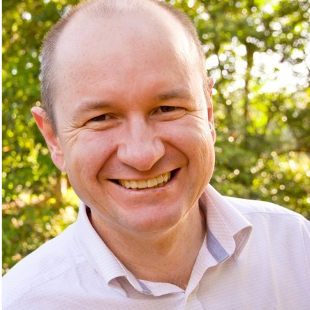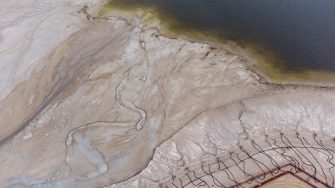
Professor Adrian Russell
For more information on the paper and other tailings research contact Professor Adrian Russell (a.russell@unsw.edu.au) or Professor Andy Fourie (andy.fourie@uwa.edu.au).
opens in a new windowNew research will help engineers interpret CPT results in variably saturated tailings more reliably

One of the major priorities of the minerals extraction and mining industries is to reduce the numbers of catastrophic failures of tailings dams.
Catastrophic failures, such as the one in 2019 at the Brumadinho tailings dam, at an iron ore mine in Brazil, can devastate the surrounding environment, land and water, as well as destroying human life and infrastructure.
Vastly improved tools for assessing static liquefaction of existing tailings dams, particularly given the exponential growth in volume and height of these facilities, are therefore greatly needed. UNSW engineers, partnering with other Australian universities and a global consortium of six mining companies are seeking to help.
Their most recent research discovery surrounds the way the cone penetration test (CPT) can be used to determine the state and strength of the tailings. New experimental evidence, backed up by comparisons with field data, underpins a new CPT interpretation framework enabling engineers to interpret CPT data in saturated and unsaturated silty tailings, as revealed in a new Geotechnique paper.
Professor of Geotechnical Engineering at UNSW Civil & Environmental Engineering and ARC Future Fellow Adrian Russell, the lead author of the paper, said “This research will help engineers directly. The CPT interpretation methods used in industry prior to these discoveries were developed primarily for saturated natural soils. There are many differences between saturated natural soils and tailings in a dam, with tailings being more silty in many cases.
“Also, there are many sections of tailings which are unsaturated, or have negative water pressures due to capillary rise when saturated. These effects have not been routinely addressed when interpreting CPT data.”
The Institution of Civil Engineers, publisher of the paper, have made it freely downloadable until August 1st, 2022.
The three-year study, involving a gold and a copper tailings, found that:
· cone penetration resistances increase due to the presence of suction when the tailings are unsaturated,
· the resistances can be normalised and used to establish relationships with the initial state parameters, for both saturated and unsaturated states, as long as the presence of suction hardening as well as the influence of suction on the mean effective stress are accounted for, and as long as the cone penetrations occur under drained conditions,
· the relationships enable state parameters to be back-calculated, and estimations of the tailings’ peak friction angles for drained loadings as well their propensities to liquefy during undrained loadings to be made.
The research was conducted as part of a large project called TAILLIQ (Tailings Liquefaction), funded by the Australian Research Council (ARC), with in-kind support and additional funding provided by Anglo American, BHP, Freeport-McMoran, Newmont, Rio Tinto and Teck Resources Limited. The TAILLIQ researchers are from The University of South Australia, The University of Western Australia (UWA), The University of Wollongong and UNSW.
TAILLIQ project leader, Professor Andy Fourie at UWA, emphasises the importance of the work. “Tailings dams fail far too often, with tailings and/or their supporting embankment reducing in strength and, in some cases, turning to a fluid-like material (a phenomenon called liquefaction) that can spread many kilometres, destroying lives, property and the environment.”
Dr Michael Davies, Senior Advisor on Tailings & Mine Waste at Teck Resources Limited, underscores the need for universities and industry to work together and close the knowledge gap. “Collaborations of this type produce outcomes than can be understood and used by industry, providing access to the most advanced research tools and techniques to help solve some of the most pressing problems”.
Professor Fourie is proud of what TAILLIQ has been able to achieve. “When embarking on a major industry-partnered research project, you aim to address the big issues and needs of the partners, and the industry at large, but there are so many smaller and important research discoveries that are made along the way.”
TAILLIQ has generated mountains of high-quality laboratory data, and field interpretations, along with new theoretical explanations and modelling tools, that relate to fundamental tailings behaviour and strengths, as well as practical guidelines. A list of publications so far can be seen at www.tailliq.com, with more to follow in the coming years. The outputs will also feature in a monograph for industry, being prepared now.
The researchers are not stopping. Professor Russell was recently awarded a Future Fellowship by the ARC, enabling him to devote 100% of his time to address the effects of aging, and earthquake loading, to help ensure the safety of tailings dams over their 10,000 year design life.